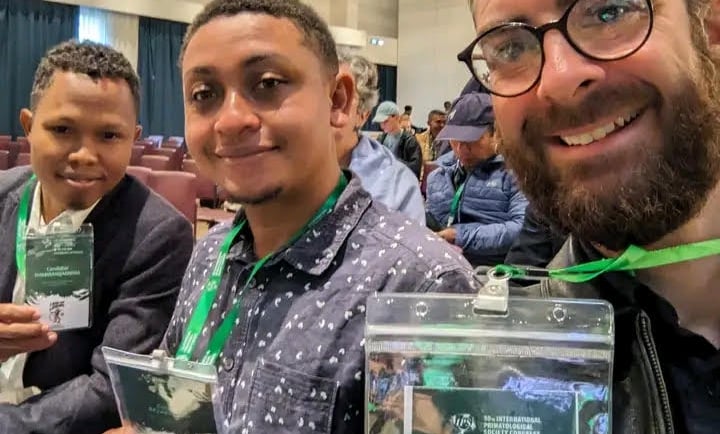Post IPS Congress Madagascar 2025 Report
Post IPS Congress Madagascar 2025 Report
Candidier
8/8/20254 min read


Attending and presenting at the 30th International Primatological Society (IPS) Congress in Antananarivo, Madagascar, from July 20-25, 2025, was a transformative and rich experience that will significantly impact me professionally and academically. As a Malagasy conservation professional studying the variation of lemur hunting among demographic groups, receiving the opportunity to share my research with a global audience of scientists, conservationists, and policymakers was invaluable.
Presenting a prosimian paper was both exciting and humbling. The opportunity to discuss my findings with others who seek solutions for the hunting of wildlife highlighted an urgent need for community-driven conservation strategies in the Northeast of Madagascar. Engaging and talking to different people during breaks and at lunch tables provided me with critical feedback that refined my methodology, especially regarding integrating the local community for alternative solutions to wildlife hunting.
The vibrant opening reception and closing fostered connections with experts like Professor Jonah Ratsimbazafy and Dr. Patricia Wright, whose conservation careers have inspired many generations.
This experience has been a pivotal moment in my career, affirming the value of my research and empowering me to advocate for lemur conservation on a global stage. I am very grateful to the Duke Lemur Center SAVA Conservation and the IPS Broadening Participation grant for making this opportunity possible. Their support not only amplified my voice but also strengthened my participation in primate conservation in Madagascar.
Here are a few things I learned during the 5 days of the IPS conference:
Various topics were presented, not only focused on the theory of primate conservation but also on adapting to new forms of conservation by using next-generation technology and engineering projects. One drone has been integrated into research monitoring and primate conservation. This has been implemented by one of the researchers in Brazil. The findings suggest the importance of technology in saving time and human resources, for example, in the inventory of wildlife species, since drones can reach further into the forest. However, a concern was raised about the effectiveness of this kind of technology because primate species may hide or move beyond the reach of the drone. Ground situations like weather and mountains may pose challenges.
Another next-generation technology has been implemented in conservation in Kenya, where a research group has used AI for conservation to benefit local communities. The AI is aimed at enabling rational decisions regarding policy implementation and benefit-sharing with local communities, such as forest rangers and ecotourism initiatives. A phone application has also been developed; GERP Madagascar already uses their own. This kind of integration is aimed at reducing the gap between different conservation partners, such as government, NGOs, stakeholders, and local communities. However, certain conference attendees raised questions regarding the use of the app and the new AI. For example, one person asked about the data policy of the app, including how to store and manage the personal data of users. Another person asked how they feed the AI data and train it, as there may be limited data available from local communities or users. The presenter explained that the project is still in its early phase and needs suggestions from everyone, and she said she would follow up for further discussion after the session.
Additionally, there was an implementation of an engineering project for conservation in South America, where canopy bridges have been constructed to help primates and other animals cross highway roads safely. It was an interesting project because it not only reduced the risk of road accidents but also the risk of animals being smuggled by people.
The credit system has been tested in the community where the conservation takes place and sparks new interest across the conservation community. Some use a direct cash payment system, and others use indirect payment in exchange for the participation of the community in the conservation and benefit sharing. Debate arises around whether this method is sustainable or not. I remember one question: what happens if the money runs out, and how does the conservation strategy ensure the sustainability of the funding source? These questions do not yet have clear answers, but we hope sooner or later we will find viable answers because it is a new strategy, and the assessment of the methods needs to be done.
For certain research topics presented, the majority were about the ecology of primates, but it was interesting to me that there were studies on genetics, diseases, and the psychological effects of their environment on them.
Since the 19th century, scientists have been researching lemurs. Currently, thousands of publications are available online; however, Malagasy scientists have contributed to less than 5% of these publications, despite Madagascar being a range country where most endemic lemurs exist. One Malagasy group of researchers is now engaged in improving this by helping Malagasy students and researchers get their work published or complete their Masters and PhD research.
Last but not least, for personal development growth, I learned a lot from observing the organization in general. The venue was a wonderful place—a 5-star hotel. As a civic sense, by watching others, I learned the importance of behaviors like keeping the place clean, queuing, being patient, not rushing for the lift—respecting the number of riders in the lifts—and sitting at the lunch table. These may seem like small things, but I feel they are very important, as I come from a region where such places and experiences were new to me. The attendees were mostly foreign nationals, and the English language was the most used for communication. I must admit that it was one of the most Western conferences I have ever attended.
